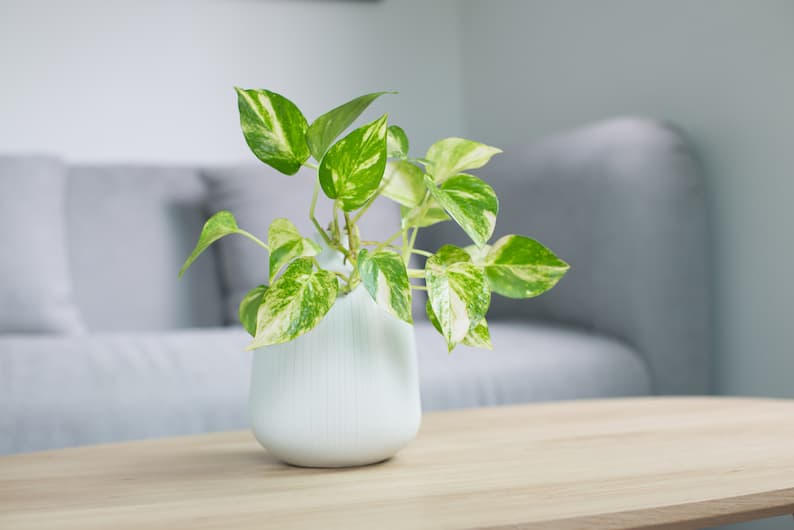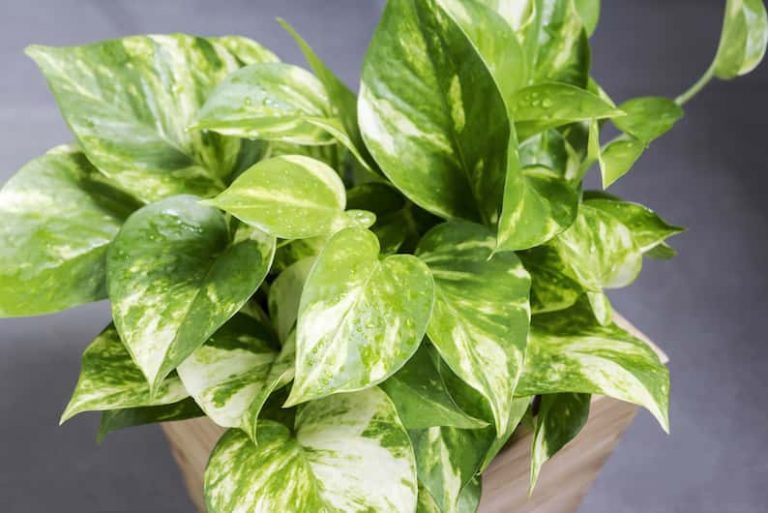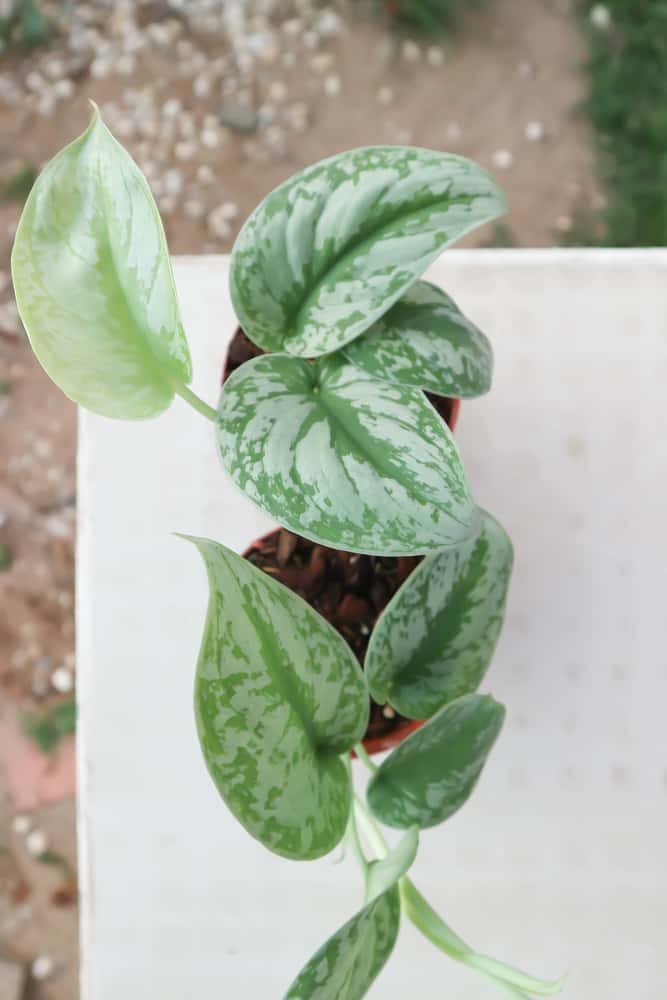All plants are beautiful to me, but the pothos variety holds a special place in my heart. In particular, variegated pothos with their incredibly patterned leaves are truly stunning.
They come in various shapes and patterns that pique the mind’s interest. They also improve the beauty of any space. You can put them up high trailing down or at eye level standing lush and proud, but one thing is certain: they have the tendency to instantly elevate a room.
That is, the pointed, heart-shaped green leaf of this trailing vine from the Solomon Islands in the South Pacific is sometimes variegated with yellow, white, or pale green markings. And which ever color variegation you end up with, you really can’t go wrong.
So keep reading to find out everything there is to know about variegated pothos.

Table of Contents
What makes a pothos variegated?
Variegated pothos have sharp color differences due to having different cells of more than one genotype. The phenomenon is known as chimeral variegation. This means that some cells cannot generate chlorophyll, resulting in color shifts or the leaves becoming totally white.
These patterns and locations of the cells are unpredictable, making rare variegated pothos patterns. The unpredictability is predominant because a particular design may cease to exist after a few plants in the same line.
A variegated pothos cutting from a rare variegated pothos type may result in a new pattern, completely different from the parent plant.
As a result, you won’t be able to make a variegated pothos on your own because mutations are challenging to duplicate and induce. Mutations appear at unpredictable intervals after several generations of propagation and aren’t always dominant enough to last more than a few crop generations.
How do I know if my pothos is variegated?
The leaves of variegated pothos will have a unique pattern with two contrasting colors. White, yellow, or light green are the most common general colors of variegated Pothos that contrast with dark green. However, some may appear to have golden, bluish, or silver shades.
The differentiation of a particular pothos is based on its appearance: the leaves’ shape, size, and color. They are also differentiated based on the predominant location of the most variegation on the leaves and their pattern( stripes, splash, or dotted.)
Some are concentrated on the borders, others in the center, while others are random splashes of color that vary from leaf to leaf.
Did you know that some diseases can actually appear to be variegation at first?
In particular, many people don’t initially realize that their Monstera has mosaic virus as it looks like a variegated pattern. Unfortunately, this virus is extremely harmful to plants so quick identification is key.
Are variegated pothos rare?
For the most part, variegated pothos plants are not rare, but there are a few exceptions. Some variegated types may be rare. For example, the newer variegated varieties are more scarce than other pothos species. When new mutations appear, it takes time for them to spread.
The reason is that there is a time restriction for propagating a variegated pothos cutting for the following generations. These kinds are the rare variegated pothos like Harlequin.
How do you encourage variegation in pothos?
Increase the amount of sunlight that the plant receives to encourage the development of new yellow, gold, silver, or white variegated pothos leaves. However, it would be better to increase the light intensity in moderation and always proceed cautiously while exposing the plant to light.
That is, it’s better to gradually increase the amount of sunshine you expose your pothos to. If the leaves are exposed to excessive sunlight, your pothos’ leaves can be sunburnt.
Can you induce variegation in a pothos?
Inducing variegation in pothos is achievable both at home and by professional cultivators. The main difference is the percentage of successful variegation. Variegation by scientists in controlled environments using various techniques is far more successful than using variegated pothos cuttings at home.
The real kicker is that variegated tissues may be induced in houseplants using various methods, involving chemical mutagens like Ethyl methanesulfonate, ionizing radiation like Gamma Rays, X-rays, or transposing genes from one variegated plant to the next.

The unfortunate thing is that producing variegation in pothos using either of these approaches is a complicated procedure that is neither practicable nor safe to try at home.
As an indoor grower, the most straightforward technique to obtain a variegated plant is to wait for a distinct genotype to arise organically. In a nutshell, here is how each of the three techniques works:
Ethyl Methanesulfonate
This is a chemical for inducing variegated pothos applied to hydrated and metabolically active seeds. The relevant pothos seeds are mixed with a low concentration phosphate buffer soaked in the EMS solution. The buffer prevents the water from breaking down the EMS in the process.
Experts soak the seeds for at least 6 hours, up to 12 hours. Alternatively, a sprouting seedling can be soaked in an EMS solution for a few hours.
However, using this technique does not guarantee that the mutation will manifest itself phenotypically. And it also does not guarantee that the mutation will result in the pattern you seek.
On the downside, using too much EMS on your pothos plant may alter the energy production system. It destroys chlorophyll, which is how plants make food. You may also have to conduct several experiments to get to the desired variegated pothos pattern.
Radiation
When pothos plant cells are exposed to radiation, the sequence of DNA is disrupted, causing biochemical alterations in the plant tissue.
The approach causes variegation and color changes. It can also result in increased growth in the number of branches, foliage, and pothos flowers. It may also result in flower and leaf sizes.
100 Grays are enough to cause the changes. The pothos plant, like all houseplants, may perish if exposed to more than 300 Grays.
By transposing
Transposing components from one crop to another plant results in the presentation of two genotypes. InnoTech Alberta, for example, has created a stable genetic construct that causes bleaching on plant cells. The variegation marks show up on the leaves as a visual signal when the desired gene is expressed within a plant’s genotype.
The improved bleaching method can be used on commercial crops. It was initially created from tobacco plants. However, it is effective for variegated house and garden plants such as Pothos.

How do you maintain variegation in pothos?
To maintain the pattern in your variegated pothos, you may do two things to promote chimeric variegation: provide ample lighting for the plant and prune all green leaves. Having enough indirect, bright light ensures the chlorophyll pigment continues to operate efficiently in variegated leaves to feed the entire plant.
This results in the pothos plant not initiating variegation since it is healthy. Remember though that too much bright sun can harm plant cells that lack chlorophyll and scorch it.
Secondly, removing all of the regular green leaves prevents the plant from getting input, indicating that green leaves are efficient at making sugars and starch.
Can variegated pothos revert?
Yes, all variegated pothos can revert. Specifically, they can revert to their corresponding non-variegated forms, displaying solid green leaves without the distinctive variegated patterns. This is a natural process and is usually due to the plant forming more chlorophyll to manufacture more energy, turning its own leaves green.
Reversion occurs when a plant is known for a specific attribute, such as its size, leaf shape, color, or other distinguishing features, and transforms back to another form that is distinctive of its lineage. In the case of variegated pothos, the leaves when reverted will have a solid green hue.

Low lighting is the major factor when it comes to a plant reverting. It is quite common among bright light-loving plants grown in low lighting conditions. In some pothos, the reversion is permanent, as in the case of the variegated Marble Queen pothos.
Marble Queen Pothos plants undergo irreversible reversion, which means that the white specks and lighter hues on the plant’s leaves return to green. And they never come back, even with brighter light exposure. The plant’s leaves then begin to develop as non-variegated sprouts.
How do you keep variegated pothos white?
If you want to keep your variegated pothos leaves white, the first thing you can do is keep them in ample bright and indirect sunlight. The pothos plant will not revert or turn green since the available chlorophyll will offer the plant enough energy.
Another thing you must do to maintain a white pothos in its current form is ensure that you offer the plant water and good soil. These two factors are fundamental, in addition to sunshine, for the pothos to manufacture food.
Lastly, using an all-purpose houseplant fertilizer for your pothos may help to prevent reversion. The pothos plant will have a supply of nutrients needed to survive, so reversion is not an option.
Back to basics: How Often to Water Your Pothos (So It Thrives)
Do variegated pothos need more light?
Yes, variegated pothos need bright, indirect sunlight. In harsher indirect light, the variegation will be more vibrant. However, the leaves will be burned if exposed to direct sunshine. On the other hand, if you place it under low light, variegated pothos may start reverting to fully green foliage.
It does this since it produces more chlorophyll to supplement its energy needs and so, when you notice this, move it to a brighter spot.
Find out exactly What Are Your Pothos’ Light Needs here!
Variegated pothos varieties
Generally, there are two main types: the common variegated pothos and the rare variegated pothos. Here are some of them:
1. Golden Pothos
The Golden pothos is adorned with golden or yellow dots on the dark green foliage. They’re effortlessly identified by their heart-shaped evergreen leaves with golden tints and are also referred to as Devil’s Ivy. Golden Pothos are one of the most durable and easy-to-grow pothos kinds.
2. Marble Queen
The variegated Marble Queen is one of the earliest variegated cultivars. They feature an identical variegation pattern to the Golden pothos, but the foliage is mostly creamy white with green specks instead.

It has a cheesecake-like appearance. The dark green and white are interlaced to make beautiful variegation, similar to a weaving or crocheted blanket.
They’ll develop slowly because each leaf has chlorophyll. To encourage their growth, position them nearer to a light source or a windowsill.
3. Snow Queen
The Snow Queen pothos is a rare variegated pothos closely connected to the Marble Queen. The variegation is a more pronounced white color instead of cream on the Marble Queen.
Find out more: Snow Queen vs Marble Queen Pothos: What’s the Difference?
4. Manjula pothos
The Manjula pothos have distinct streaks of silver, cream, light green, and white. The heart-shaped leaflets of Manjula pothos have curving borders that resist laying flat, distinguishing them from other pothos types.
5. Jessenia pothos
Green heart-shaped foliage studded with greenish-yellow tones characterizes Jessenia pothos. Every blade of Jessenia pothos will be distinct from the others with a random pattern. You might mix them up with the Marble Queen because of the uncanny resemblance.
Nevertheless, you will be able to see the difference between Jessenia and the Marble Queen because of Jessenia’s color. Their limey-green variegation is considerably darker than Marble Queen’s brighter, whiter variegation.
6. Pearls and Jade pothos
It’s one of the rare variegated pothos and patented by the University of Florida. Unlike most pothos, these have white or silver variegation along the edges instead of the middle.
You can easily confuse it with the N’Joy. But check for green spots on the white patches to confirm they are Pearls and Jade.
7. Variegated Neon pothos
These are Pothos that have bright lime-green leaves with dark green variegated stripes. The younger, sprouting leaves have vibrant colors, and the mature, older leaves have a deeper neon tint.
Grow your variegated neon pothos under bright sunlight to get that dazzling neon color. The leaves are dull and black in low or dim light.

8. Cebu Blue Pothos
The blue-green leaves of the Cebu Blue pothos are fashioned like an arrow. In addition, the leaves frequently have a little bluish-metallic sheen to them, which distinguishes them from other varieties.
Under the right luminescence conditions, the pothos variety’s silvery-blue, glossy leaves like to shimmer.
9. Satin Pothos
They are also called the Scindapsus pictus. It has broad heart-shaped leaves that have silvery splashes.
Perhaps unsurprisingly, this plant is very similar in looks to the Silver Pothos and Silver Satin pothos. The variety has smaller leaves than the other kinds. To achieve the brightest colors of silver, maintain it in bright but indirect light.

10. Harlequin Pothos
Harlequin pothos are the most difficult to obtain. It resembles Manjula and appears to be a cross between Marble and Snow Queen pothos, with some more variegation on the foliage.
11. Hawaiian Pothos
The Hawaiian pothos has large dark green foliage with yellow dots and specks, generating more color contrast than the Golden Pothos.
12. Glacier
The Glacier pothos is also one of the rare variegated pothos species. It has irregular white streaks on the leaves, creating an illusion of glacial ice.
13. N’Joy
The N’Joy pothos variety has small leaves with big patches of white variegation that often attach to the foliage’s exterior borders.
Are all pothos able to be variegated?
Yes, all types of pothos can variegate given that variegation is essentially a genetic mutation. No particular factor determines a gene mutation; it just happens or is induced. That said, you can use cuttings, EMS, radiation, or transposing to induce variegation on any pothos.
However, unless you’re a scientist, most of those strategies won’t work. For most of us at-home gardeners, the best way to get a variegated pothos is to get a cutting.
Are neon pothos variegated?
Some neon pathos are variegated. There are types of neon pothos that are diversified due to a gene mutation, especially when exposed to sufficient amounts of bright, indirect light.
Is Golden pothos variegated?
Yes, they are variegated. Golden Pothos have heart-shaped leaves with golden or yellow dots or splashes on their plump green leaves. In fact, this is where they get their name from, as the splashes of gold make these quite sought after.
Where to get a variegated pothos
Most variegated pothos varieties are common, so they’re not hard to get. So take a look at your nearby nursery or internet seller. Alternatively, contact a specialty grower in your region. If you’re looking for a rare pothos variety, look for it at a specialty houseplant store or on an internet marketplace like Etsy.
To guarantee getting the right type, make sure the vendor is credible before purchasing.
Because of their rareness and the quantity of propagation required to recreate the variegation considerably, some cultivars will be more costly than the common ones. More variegated types, such as Snow Queen, Harlequin, or N’Joy, will set you back more, as these varieties are in high demand.

What’s a standard variegated pothos price?
The cost will vary depending on where you purchase the plant, its stage of development, size, and type. In general, common Pothos are less expensive than rare variegated pothos. So much so that the entire pothos species usually ranges in price from $4 to $30 per plant on Etsy.
If the site selling them provides bundle options, you can purchase them at a collectively discounted price.
All in all, no matter the cost, a pothos is a special houseplant that transforms your living room into a stunning place. Having the plant will give you courage to invite guests into your home. Most people will appreciate the magnificent plant and want to get one for their home.
Final thoughts on the variegated pothos
Pothos have been in high demand as a houseplant in recent years, but securing a variegated pothos is really seen as the gold standard.
It helps that there aren’t too many rare variegated pothos, so you shouldn’t have too much trouble finding a plant or variegated pothos cutting to buy, especially the more common varieties. And given how amazing they look, the relatively low price is just icing on the cake.
The one thing to keep in mind is the slightly different light needs of this type of plant, as the fact that the leaves have less green on them may mean you need to provide different amounts of light from what a non-variegated version would need. But once you have that under control, you’ll never refret adding a variegated pothos to your collection.
